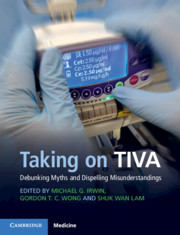Book contents
- Taking on TIVA
- Taking on TIVA
- Copyright page
- Contents
- Contributors
- Foreword
- Power to the People: the Rationale of a Practical Text
- Chapter 1 Why Bother?
- Chapter 2 You Say ‘PK’ and I Say ‘No Way!’; You Say ‘Keo’ and I Say ‘Time to Go!’
- Chapter 3 TCI and TIVA: What a Good Idea!
- Chapter 4 Milk of Amnesia
- Chapter 5 A Catwalk with a Difference
- Chapter 6 Let’s Get Started
- Chapter 7 Let’s Get Pumped!
- Chapter 8 ‘But I’m Used to MAC!’
- Chapter 9 Be Aware, Unaware and Confusion Everywhere
- Chapter 10 Do You Want Fries with That?
- Chapter 11 Intra- and Post-operative Analgesia for TIVA
- Chapter 12 Wakey Wakey!
- Chapter 13 Under Pressure
- Chapter 14 Ankle Biters
- Chapter 15 Old Timers
- Chapter 16 Big Can Be Beautiful!
- Chapter 17 A Bun in the Oven
- Chapter 18 Saving the Whales by Taking on TIVA
- Chapter 19 TIVA Drugs for Sedation
- Chapter 20 Skiing Off-Piste and Other Assorted Goodies
- Index
- References
Chapter 2 - You Say ‘PK’ and I Say ‘No Way!’; You Say ‘Keo’ and I Say ‘Time to Go!’
Pharmacokinetics for TIVA
Published online by Cambridge University Press: 18 November 2019
- Taking on TIVA
- Taking on TIVA
- Copyright page
- Contents
- Contributors
- Foreword
- Power to the People: the Rationale of a Practical Text
- Chapter 1 Why Bother?
- Chapter 2 You Say ‘PK’ and I Say ‘No Way!’; You Say ‘Keo’ and I Say ‘Time to Go!’
- Chapter 3 TCI and TIVA: What a Good Idea!
- Chapter 4 Milk of Amnesia
- Chapter 5 A Catwalk with a Difference
- Chapter 6 Let’s Get Started
- Chapter 7 Let’s Get Pumped!
- Chapter 8 ‘But I’m Used to MAC!’
- Chapter 9 Be Aware, Unaware and Confusion Everywhere
- Chapter 10 Do You Want Fries with That?
- Chapter 11 Intra- and Post-operative Analgesia for TIVA
- Chapter 12 Wakey Wakey!
- Chapter 13 Under Pressure
- Chapter 14 Ankle Biters
- Chapter 15 Old Timers
- Chapter 16 Big Can Be Beautiful!
- Chapter 17 A Bun in the Oven
- Chapter 18 Saving the Whales by Taking on TIVA
- Chapter 19 TIVA Drugs for Sedation
- Chapter 20 Skiing Off-Piste and Other Assorted Goodies
- Index
- References
Summary
Anaesthesia is possibly the most pharmacology oriented of all clinical medical specialties. What we do every day is, effectively, applied pharmacology. Yet with all this practical experience, some aspects, particularly pharmacokinetics, can appear dauntingly complex. Indeed, mathematical modelling and developing target-controlled infusions is difficult as is the design of modern vaporisers for inhalational drugs but, as an analogy, we don’t need to be able to design a car in order to know how to drive it. However, there are certain basic PK features that will enhance your understanding and improve your ability to use these drugs appropriately.
- Type
- Chapter
- Information
- Taking on TIVADebunking Myths and Dispelling Misunderstandings, pp. 5 - 13Publisher: Cambridge University PressPrint publication year: 2019



